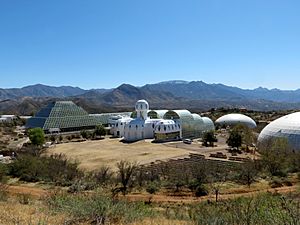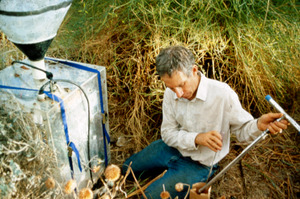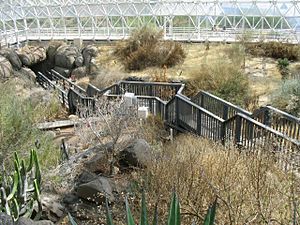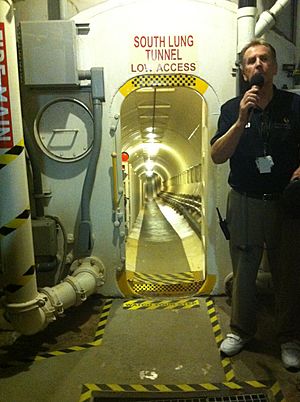Biosphere 2 facts for kids
Quick facts for kids Biosphere 2 |
|
|---|---|

Exterior of Biosphere 2
|
|
| General information | |
| Type | Research facility |
| Location | Oracle, Arizona, United States |
| Address | 32540 S Biosphere Rd, Oracle, AZ 85739 |
| Coordinates | 32°34′44″N 110°51′02″W / 32.578778°N 110.850594°W |
| Elevation | 3,820 ft (1,164 m) |
| Construction started | 1987 |
| Completed | 1991 |
| Owner | University of Arizona |
| Technical details | |
| Floor area | 3.14 acres (12,700 m2) |
| Grounds | 40 acres (160,000 m2) |
Biosphere 2 is a special science building in Oracle, Arizona, USA. It's a place for studying Earth, its living systems, and our planet's role in the universe. This huge structure, about 3.14-acre (1.27-hectare) big, was first built to be a completely closed system. This means it was sealed off from the outside world, like a giant terrarium. It is still the biggest closed living system ever made.
Built between 1987 and 1991, Biosphere 2 was designed to see if humans could live in a sealed environment. This was important for thinking about future space colonization. It also helped scientists learn how different parts of nature work together. Inside, there were several different natural areas called biomes. There were also living spaces for people and an area for growing food. This allowed scientists to study how humans, farming, and technology interact with nature. The main goal was a two-year experiment with eight people living inside.
The building had seven different biomes: a 1,900-square-meter (20,000 sq ft) rainforest, an 850-square-meter (9,100 sq ft) ocean with a coral reef, 450-square-meter (4,800 sq ft) mangrove wetlands, a 1,300-square-metre (14,000 sq ft) savannah grassland, and a 1,400-square-meter (15,000 sq ft) fog desert. There were also two human-made areas: a 2,500-square-meter (27,000 sq ft) agricultural system for farming and a habitat with living quarters and labs. Underneath the main structure was a large area with technical equipment. This equipment helped control the temperature and provide power.
Biosphere 2 was used for its original closed-system experiments only twice. The first mission was from 1991 to 1993. The second was from March to September 1994. Both missions faced challenges. These included low food and oxygen levels, and some plants and animals dying. However, the experiments set world records for closed ecological systems. They also showed how complex living systems can organize themselves. The second mission even managed to grow all its own food and did not need extra oxygen.
In 1995, Columbia University took over managing the facility. They used it for experiments until 2003. In 2007, the University of Arizona began using it for research. The University of Arizona fully owned Biosphere 2 by 2011.
Contents
Building Biosphere 2
The idea for Biosphere 2 started in 1984. A businessman named Ed Bass and an ecologist named John P. Allen launched the project. Ed Bass provided a lot of money to build it. They wanted to explore the idea of creating self-contained living systems.
Construction happened between 1987 and 1991. The project was called "Biosphere 2" because Earth itself is "Biosphere 1." The goal was to create the second fully self-sufficient biosphere.
Where it is located
The glass and steel building is in Oracle, Arizona. It's at the bottom of the Santa Catalina Mountains, about 50 minutes north of Tucson. The building is about 4,000 feet (1,200 m) above sea level.
How it was built
The main structure of Biosphere 2 is made of steel and special glass. The designers made sure the building was almost perfectly airtight. This was important so that air could not easily escape or enter. This tight seal helped scientists track small changes inside.
During the day, the sun's heat made the air inside expand. At night, it cooled and shrank. To handle these changes, the building had large flexible domes called "lungs." These lungs allowed the air to expand and contract without damaging the structure.
Since windows could not be opened, a complex system controlled the temperature. This system used heated and cooled water flowing through pipes. An energy center on site provided electricity and controlled the water temperature. All the technology was chosen to avoid releasing harmful substances inside.
The First Mission
The first mission inside Biosphere 2 lasted two years. It began on September 26, 1991, and ended on September 26, 1993. Eight crew members, called "biospherians," lived inside.
The farming area produced most of their food, about 83% of their diet. They grew bananas, papayas, sweet potatoes, rice, and wheat. They also had animals like goats, chickens, pigs, and tilapia fish. The farm was very productive, much more than many farms outside.
The crew followed a special low-calorie, nutrient-rich diet. Their health improved greatly during the two years. They had lower cholesterol and blood pressure. Their immune systems also became stronger. They lost some weight at first, but then their bodies adapted. This showed that the environment inside Biosphere 2 was healthy.
Scientists included many different types of plants and animals. This was to make sure the ecosystem would keep working even if some species died. The fog desert became wetter than expected. The rainforest plants grew very fast. The ocean area had corals that reproduced. The crew helped keep the ocean healthy by cleaning it. The mangrove area also grew well.
Many of the larger animals and most of the pollinating insects died. However, plants and some smaller animals did reproduce. Insect pests, like cockroaches, grew in number. Biosphere 2 was like a small island ecosystem.
Challenges of the First Mission
The first mission faced several challenges. The desert biome became too wet because of condensation. There were too many cockroaches and ants. Some plants, like morning glories, grew too much in the rainforest. Also, less sunlight entered the building than expected. The crew had to work to control these issues.
It was also hard to create natural features like waves and tides in the ocean. Engineers found clever ways to do this. For example, they used vacuum pumps to make gentle waves.
One challenge was that the oxygen levels inside slowly dropped. After 16 months, the oxygen was much lower than outside. This was like being at a very high altitude. Because some crew members felt tired, they added oxygen in 1993. Scientists later found that the concrete inside was absorbing carbon dioxide and oxygen. This helped them understand how complex ecosystems work.
Managing carbon dioxide (CO2) levels was also tricky. CO2 levels changed a lot each day. Plants absorbed CO2 during the day, and then it rose at night. The crew tried to control CO2 by using a special scrubber and by managing the plants.
The Second Mission
After the first mission, scientists made improvements to Biosphere 2. They sealed the concrete to stop it from absorbing CO2. The second mission started on March 6, 1994. This time, the crew was able to grow all the food they needed.
The second mission ended earlier than planned on September 6, 1994. After this, Columbia University changed Biosphere 2. It was no longer a completely closed system. Instead, they could control CO2 levels for different experiments.
Science from Biosphere 2
Many scientific papers have been written about the research done at Biosphere 2. These papers describe how the system worked. They also show how the rainforest, mangrove, and ocean areas developed.
Research during Columbia University's time showed how rising CO2 levels can harm coral reefs. This was an important finding for understanding climate change. Studies also showed that plants in the biomes could only absorb a certain amount of CO2. This highlights how important large experiments are for studying global changes.
University of Arizona Takes Over
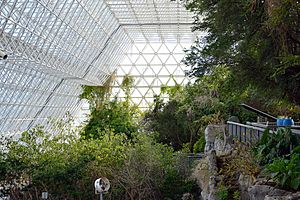
In June 2007, the University of Arizona announced it would take over research at Biosphere 2. This news was good because it meant the building would not be torn down. The university received money from private donations to cover costs. In 2011, the university became the full owner of Biosphere 2.
Ed Bass, who helped start the project, donated more money in 2011 and 2017. This money helps support the science and operations at Biosphere 2.
Today, Biosphere 2 also hosts science camps for students. Many visitors come to see the campus each year.
Current Research
Biosphere 2 is still a very active research facility. Here are some of the big projects happening there:
- The Landscape Evolution Observatory (LEO): This project uses many sensors to study how non-living rock slowly turns into rich soil over many years. It helps scientists understand how soil develops and supports life.
- The Lunar Greenhouse: This project is testing how to grow vegetables on the Moon or Mars. It uses plants to recycle and clean water.
- A vertical farming project: This project aims to grow plants indoors using special LED lights. The goal is to use less water, create no pollution, and grow food without pests.
See also
 In Spanish: Biosfera 2 para niños
In Spanish: Biosfera 2 para niños
- BIOS-3, another closed ecosystem in Russia
- Eden Project
- IBTS Greenhouse
- Institute of Ecotechnics
- Mars analog habitats
- Flashline Mars Arctic Research Station (FMARS)
- Mars Desert Research Station (MDRS)
- MARS-500, an experiment simulating a trip to Mars
- HI-SEAS
- MELiSSA, a closed ecosystem run by the European Space Agency
- Yuegong-1, a closed ecosystem experiment in Beijing, China


